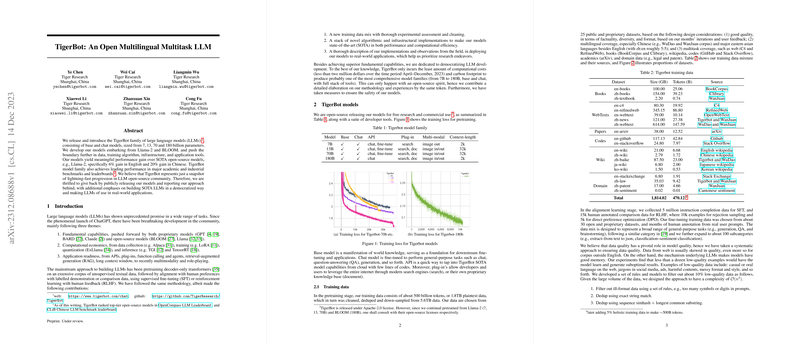Introduction
LLMs have transformed the AI landscape with capabilities that seem to inch closer to artificial general intelligence (AGI). Their functionality spans across various domains, imparting them with skills ranging from simple question-answering to complex coding tasks. The evolution of LLMs has been chiefly driven by the advancement in their foundational capabilities, computational efficiency, and readiness for real-world applications. This typically involves pretraining on an extensive corpus of data and then refining them through supervised and reinforcement learning techniques. TigerBot is an addition to the cohort of LLMs, following a lineage of models while carving out its own niche in both performance and application diversity.
TigerBot Models
TigerBot is a multifaceted LLM, ranging from 7B to 180B parameters, designed for an array of multilingual multitask applications. It is openly available for both research and commercial use, offering an array of tools and a developer-friendly API. The models incorporate extensive training data, roughly equating to 500 billion tokens that have been thoroughly vetted for quality and diversity, encompassing a significant portion of Chinese language data and a wide range of tasks. Additionally, TigerBot has been released with various developer tools and maintains compatibility with contemporary search engines and knowledge bases.
Training Methods and Data
Underpinning TigerBot's abilities is a diverse dataset comprising public and proprietary sources, meticulously curated for quality and multilingual coverage. The model expands its language capacity by blending tokenizer vocabularies from prominent multilingual models like BLOOM and experimenting widely with parallelism strategies during training. TigerBot's multilingual, multitask coverage, combined with a suite of novel algorithmic and infrastructure enhancements, propels it into the upper echelons of open-source LLMs. This has been achieved at a modest computational cost, with an emphasis on low carbon footprint, aligning with the ethos of democratizing LLM development.
Applications and Safety
The versatility of TigerBot manifests in various applications, ranging from long-context QA and online search augmentation to more niche uses like role-playing and function calling, demonstrating a revolutionary potential for practical utility. Moreover, the model addresses safety concerns through comprehensive filtering during training and runtime, ensuring the outputs are aligned with human values. With safety as a priority, TigerBot remains aligned to core social values and legal considerations by integrating monitored iterative alignments with real user data.
Conclusion
In summary, TigerBot is an exemplary model of bringing together state-of-the-art training techniques, a broad data approach, and real-world application readiness, all underlined by a commitment to accessibility and safety. As the journey of LLMs and AGI continues, TigerBot demonstrates both the immense potential and the ongoing challenges in the field, reinforcing the continuous need for innovation and prudent application development. Its open-source release not only contributes to the thriving AI community but also stakes a claim for the future trajectory of AI research and development.
